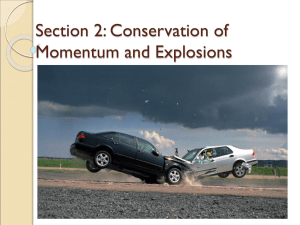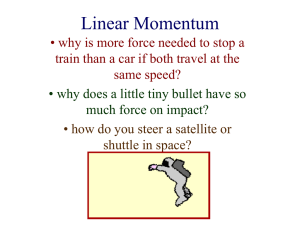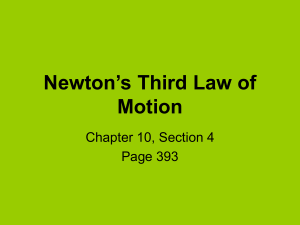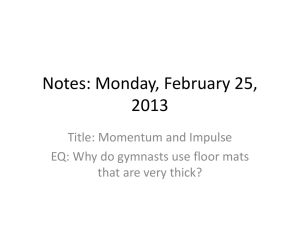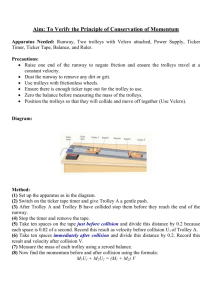MOMENTUM & CoM
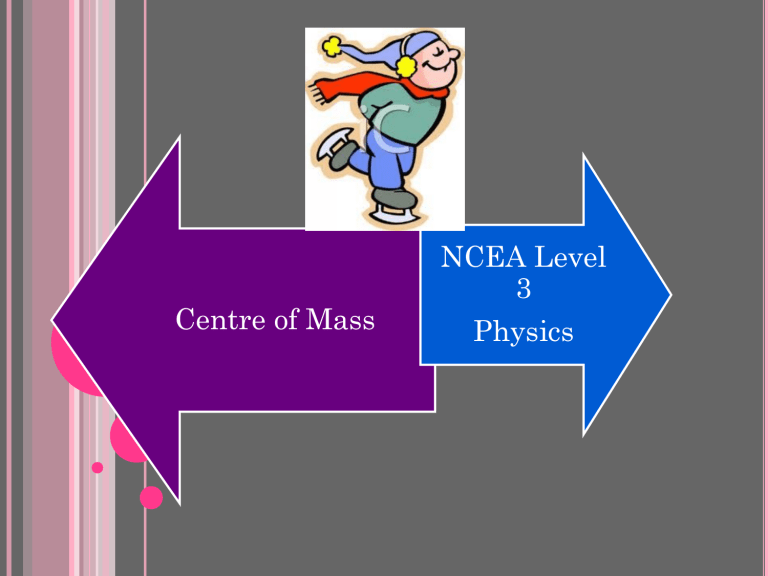
Centre of Mass
NCEA Level
3
Physics
This is a useful tool for studying collisions, explosions and other forms of motion.
Centre of mass = point where the total mass acts.
Another name for it is centre of gravity.
This is of paramount importance in architecture:
CoM
CoM
Centre of mass acts through base
building stable.
E.g. the leaning tower of Pisa
Centre of mass is not supported by the base, result is building falls
CoM
The foundations subsided which caused the tower to lean. However, because the
CoM is over the base the tower will not topple over.
As people walk up to the top of the tower the CoM shifts over time. As a result the CoM moves further along until eventually the base will not support it and it will fall.
When analysing the motion of more than one object, it is often useful to be able to consider the group of objects as a single object called a
system.
Calculating the position of the CoM:
The CoM can be calculated as a ratio along the distance between two masses:
4kg 1kg
MgX = mgx
MX = mx
M/m = x/X
MX = m(d-X)
•CoM is four times closer to the 4kg mass than the 1kg mass.
•If the distance between the two masses is 12m then the
CoM is 2.4m from the 4kg mass.
4kg
MgX = mgx
MX = mx
M/m = x/X
MX = m(d-X)
4x = 1 ( 12 – x)
4x = 12 – 1x
5x = 12 x = 2.4 m from 4kg
1kg
12m
Example 1:
The Earth and Moon are like a two particle system, if we imagine all their mass as concentrated at their CoM.
Calculate the distance of the CoM of the Earth-Moon system from the centre of the Earth.
Mass of Earth = 600 x 10 22 kg
10 22 kg
Mass of moon = 7.3 x
Distance between Earth & moon = 3.8 x 10 5 km
SOLUTION:
Distance between Earth & Moon = 3.8 x 10 8 m
Earth:
600x10 22 kg
X
CoM
Moon:
7.3x10
22 kg
d = X + x
MX = m(d – X) X is the distance from the centre of the earth
X = md/(M + m) Rearranging
X = 7.3x10
22 x 3.8x10
8 / (600x10 22 + 7.3x10
22 )
X = 4.6 x 10 6 m
As the radius of the earth is 6.4 x
10 6 m, the centre of mass of the earth-
Moon system is beneath the earth’s surface. While it is usually said that the Moon orbits the earth, it would be more correct to say that the Moon orbits the earth each orbit around their common CoM.
CoM & Conservation of Momentum
Any form of calculation involving a collision, as you learnt last year, can be solved using momentum.
= mv
The law of conservation of momentum can also be used for isolated systems. The behaviour of the system can be analysed by looking at what happens to its CoM.
system
= m system x v
CoM
system
= (M + m) x v
CoM
If the system is isolated then the momentum will not change. The masses of the individual particles also remain the same thus the v
CoM remain constant.
must therefore
The momentum of a system is also the total momentum of the particles that make up the system.
system
= Σ particles of system
system
= (M + m) x v
CoM
(M + m) x v
CoM
= Mv
M
+ mv m
As two objects approaching each other collide they can change both their speed and direction, but their CoM moves with a constant velocity . The velocity of the
CoM is unchanged by the collision.
Example 2:
A 2000kg truck moving at 8.0ms
-1 hits a stationary car of mass
1200kg. After the accident, the two vehicles are locked together.
Calculate the velocity of the truck and car after the collision.
BEFORE
2000kg
8ms -1
1200kg
AFTER
2000kg
1200kg vms -1
SOLUTION:
The total momentum before the collision = (2000 x 8.0) + (1200 x 0)
= 16000 kgms -1
The velocity of the CoM before the collision is given by: v
CoM
= total momentum / total mass v
CoM
= 16000 / (2000 + 1200) = 5.0 ms -1
This will also be the velocity of the CoM after the collision. Since the vehicles are locked together their velocity after the collision will also be
5.0 ms -1 .
COMPLETE EXERCISES-
RUTTER
PAGE 34 - 38
Momentum
NCEA Level
3
Physics
Why can’t it stop easily ??
1. It is MASSIVE
2.
It is FAST
IT has a lot of
MOMENTUM
= mv
=
f
-
i
Example 3: Conservation of
in 2-dimensions
The diagram shows a radioactive nucleus, which was initially at rest, immediately after it has decayed. An emitted electron moves off in a northerly direction, a neutrino moves off in an easterly direction, and the decayed nucleus moves off in a different direction.
Electron
Decayed nucleus
Neutrino
The momentum of the electron is 1.2 x 10 -22 kgms -1 , and that of the neutrino is 6.4 x 10 -23 kgms -1 .
Calculate the size of the momentum of the nucleus after the decay.
SOLUTION:
Σ
(before) = Σ
(after)
Σ
(before) = 0
Σ
(after) = 1.2 x 10 -22 kgms -1
+ 6.4 x 10 -23 kgms -1
+
(nucleus)
(nucleus) = 0 – 1.2 x 10 -22 kgms-1
6.4 x 10 -23 kgms-1
(nucleus) =
(1.2x10
-22 ) 2 + (6.4x10
-23 ) 2
= 1.4 x 10 -22 kgms -1
(nucleus)
6.4x10
-23 kgms -1
Impulse: If we change the velocity of an object then it has been accelerated and thus has been acted upon by an unbalanced force. A change in velocity thus results in a change in momentum.
The change in momentum is called IMPULSE.
Substituting both
OR
F = ma a =
v/
t
F = m
v/
t
F
t = m
v
F
t =
Example 4: Impulse in 2-dimensions
A ball of mass 100g is moving north at 5.0ms
-1 . Raj hits the ball with his stick so that it travels west at 12ms -1 .
The diagram is a view from above and shows the position of the stick at the instant the ball is hit.
a. Find the size and direction of the change in momentum of the ball.
b. If the stick is in contact with the ball for 0.020s, what is the magnitude and direction of the average force acting on the ball.
12ms -1
5ms -1
SOLUTION: a. Initial i
= mv
= 0.10 x 5.0
= 0.50 kgms -1
Final f
= mv
= 0.10 x 12
= 1.2 kgms -1
= f
I
= 1.2 kgms -1 - 0.50 kgms -
1
Using trigonometry: tan = 0.50 / 1.2
= 23 o
= 1.2
2 + 0.50
= 1.3 kgms -1
2
23 o
1.2kgms
-1 south-west
b. The average force F on the ball can be calculated from:
F t =
F x 0.020 = 1.3
F = 1.3 / 0.020
F = 65N (in the same direction as )
DO
EXERCISE
10 FROM
Page 15
S&C
Just like with force components horizontal and vertical components for momentum can be conserved.
This means that all the horizontal components of vectors before a collision must equal all the horizontal components of vectors after the collision.
The same is true for all vertical components.
x
1
BEFORE x
2
AFTER y
3 y
1
A
B y
2
A+B x
3
HORIZONTALLY: x
1
VERTICALLY: y
1
+ x
+ y
2
2
= y
= x
3
3
RESULTANT = x
3
+ y
3
Use trigonometry
All energy is also conserved as well as momentum. Thus energy before is the same as energy after as long as there has been no external input. The main energies we may have to look at are:
Kinetic energy
Gravitational potential energy
Work done
E k
= ½ mv 2
E p
= mgh
W = Fd
Power
P = W/t
Remember if all energy is conserved then the collision is ELASTIC . If energy is lost then it is INELASTIC.
Paddys Note: C drive/PYX/Vol2/Mechanics/Forces
DO
EXERCISES
PAGE 38 -43
RUTTER
DO THE
HOMEWORK
WORKSHEET
ON
MOMENTUM
& ENERGY



